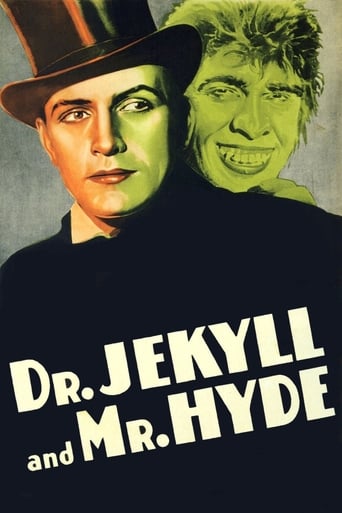Put yourself in her place! The dreaded night when her lover became a madman!
Ante un auditorio científico el doctor Henry Jekyll expone su teoría de que el ser humano está dividido en dos personalidades, una positiva y otra negativa, y que ambas se pueden separar, pero no logra convencer a sus oyentes. Después de visitar a su prometida Muriel, y paseando con su amigo el doctor Lanyonal que intenta convencer de que su idea es viable, conoce a una joven artista de music-hall, Champagne Ivy. En su laboratorio Jekyll experimenta con una droga y se transforma en el señor Hyde y, bajo esta personalidad y por medio de amenazas, se convierte en amante de Ivy...
"Dr. Jekyll and Mr. Hyde" (1931), a cinematic masterpiece produced by Paramount Pictures in the United States, is a chilling adaptation of Robert Louis Stevenson's iconic novella. Directed by Rouben Mamoulian, the film stars Fredric March in a riveting dual role as the benevolent Dr. Henry Jekyll and his malevolent alter ego, Mr. Edward Hyde. The film's innovative use of camera techniques and special effects for its time, including the groundbreaking transformation scenes, set a new standard for horror cinema. March's transformative performance earned him an Academy Award for Best Actor, solidifying the film's place in cinematic history. The narrative delves deep into the psychological and moral complexities of its protagonist, Dr. Jekyll, who becomes obsessed with separating the good and evil within human nature. His experiments lead to the creation of Mr. Hyde, a manifestation of his darker impulses, which he initially believes he can control. However, as Hyde's influence grows, Jekyll's life spirals into chaos, threatening those he holds dear. The film's exploration of duality and the battle between morality and immorality resonates powerfully with audiences, making it a timeless piece of storytelling. Visually, "Dr. Jekyll and Mr. Hyde" is a triumph, with its atmospheric cinematography and meticulous set design enhancing the film's eerie tone. The use of subjective camera angles and point-of-view shots immerses viewers in Jekyll's perspective, heightening the sense of dread and disorientation as he loses control. The film's score, composed by Herman Hand and Karl Hajos, complements the visual elements, creating a haunting auditory experience that amplifies the tension and horror. In conclusion, "Dr. Jekyll and Mr. Hyde" (1931) remains a landmark film in the horror genre, celebrated for its bold storytelling, groundbreaking technical achievements, and unforgettable performances. Its enduring legacy is a testament to the power of cinema to explore the darkest corners of the human psyche, captivating and terrifying audiences across generations.
Año1931
Presupuesto535000$
Duración98 minuto
Ingresos1300000$
Ver en línea
GénerosTerrorCiencia ficciónDrama
Países de producciónUnited States of America

